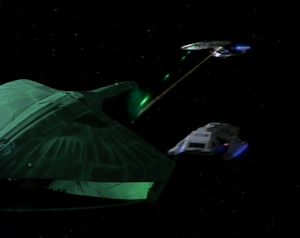| |||||||||||
| |||||||||||
|
Spoiler-free notes: That's an awful roomy shuttlecraft. Actually, it's a runabout--a larger vessel than a shuttlecraft designed for longer distance reconnaisance and typically assigned to starbases--but that raises all kinds of other questions, most notably when did the Enterprise get one and why haven't we seen it before? Okay, I'm imagining these three-dimensional bubbles in which time works differently, a cool concept to be sure. However, if the runabout is moving and hits one of these bubbles, wouldn't the pieces of the runabout within the bubble move slower than the rest, thus causing the craft to be ripped apart by the sudden inertial stress of parts of it moving faster than other parts? (Of course, this whole concept treats space and time as discrete entities, which Einstein realized is completely untrue.) Additionally, with the runabout moving so quickly through space, how would the effects of these bubbles last any longer than a tiny, imperceptable fraction of a second? I suppose it's theoretically possible that they are moving in almost exactly the same direction and speed, but that seems ludicrously unlikely. Troi does some plexing when she's telling Picard about what she experienced. There's a nice reference to "Time's Arrow" when Picard asks Data if they can use a subspace forcefield like they did on Dividia II. Wouldn't it be prudent to send just one person first, to make sure the personal time forcefields work? How do they manage to get signals back and forth between the away team and Geordi? The communication signals would have to travel through the area of frozen time, where they would assuredly stop moving. It had to be a pain in the ass for all the actors and extras to stand perfectly still at all times. The Romulan who suddenly moves is very similar to a scene in "The Next Phase." The proposal to rewind time enough to "redo" events reminds me of the Omega-13 device from Galaxy Quest. Every season of TNG (except Season 4) has at least one episode dealing explicitly with time travel, and it has almost become its own character on the show, developing right alongside the regular crew. "Timescape" seems to build on the ideas of "Cause and Effect" and "Time's Arrow," but it deals with time in a completely novel way. I like the puzzle show aspects of it--showing us a series of frozen events and daring us to figure out what's going on in each--and I like some of the more philosophical questions it raises. However, the aliens responsible for everything aren't adequately explained, the ending is way too abrupt, and the writers don't get into the many ramifications of what would really happen to the physical universe if time was affected as it is. As sci-fi, it's a little undercooked, but as a cool Star Trek episode that shows us something new and exciting, it's a clear success. | |||||||||||
|
| |||||||||||
| |||||||||||
|
Copyright ©2012 e. magill. All rights reserved.
|

